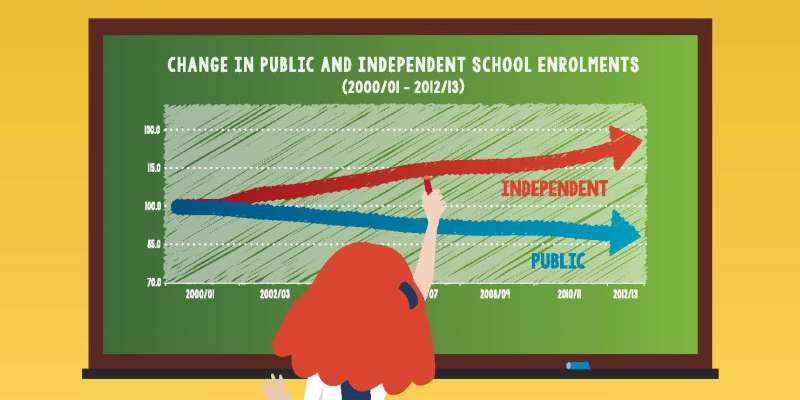Where Our Students are Educated: Measuring Student Enrolment in Canada

Building from the previous edition of this report, released in February 2014, this study expands and updates the measurement of choice and competition across Canada’s 10 provinces, by focusing in particular on student enrolments in the various education sectors. As one might expect, given the decentralized nature of K–12 education in Canada, the mix of public, independent, and home-based education varies by province, as does the funding and regulation of these sectors. Some provinces rely more heavily on choice and competition within the public systems, while others rely more heavily on independent schools to provide choice and competition.
Across Canada, the public school systems remain by far the largest providers of education. In 2012/13, between 87.3 percent (Quebec) and 98.7 percent (New Brunswick) of K–12 students are enrolled in public schools. However, there is a great deal of misunderstanding about school choice and competition within public school systems. Frequently, the large share of enrolment in public schools is equated with a lack of school choice and competition. The reality is more complicated. It is the case that the majority-language public schools—Anglophone in all provinces except Quebec, where it is Francophone—dominate enrolment, educating between 63.1 percent (Ontario) and 98.0 percent (Newfoundland and Labrador) of students.
Nevertheless, the proportion of students enrolled in public schools has declined over time. Every province has seen a decline in the proportion of students enrolled in the public system from 2000/01 to 2012/13. Quebec and British Columbia have seen the largest declines in public enrolment as a proportion of total enrolment in this period, from 90.6 to 87.3 percent in Quebec and from 90.8 to 88.1 percent in British Columbia.
The general reduction in public school enrolment has been met both with increased enrolment in independent schools and with a larger share of families choosing to home school their children. Quebec and British Columbia saw the largest increases in the share of independent school enrolment, from 9.4 to 12.6 percent in Quebec and from 8.6 to 11.6 percent in British Columbia from 2000/01 to 2012/13.
The nature of the independent school sectors, their funding, and their regulation varies greatly by province, as does enrolment. In 2012/13, student enrolment in independent schools as a proportion of total enrolment ranged from 0.7 percent in New Brunswick to 12.6 percent in Quebec. British Columbia (11.6 percent), Manitoba (7.6 percent), and Ontario (5.6 percent) also recorded comparatively high levels of independent school enrolment.
Critically, the range of parental choice and competition provided in the public education system depends on one’s province (and city). Generally speaking, Alberta offers the greatest degree of school choice in Canada. Apart from having five fully-funded public school choices, although not all are equally accessible, it also provides substantial funding for students wishing to attend independent schools and for parents wishing to educate their children at home. The presence of charter schools provides parents with additional options outside traditional linguistic and religious alternatives offered by public school boards.
At the other end of the spectrum, the Atlantic Provinces tend to offer comparatively less parental choice and competition between schools. None of the Atlantic Provinces provide parallel public religious school systems, nor do they offer funding for parents who choose independent schools. The remaining provinces range between Alberta and the Atlantic Provinces with respect to the level and depth of parental choice and competition for schools.





